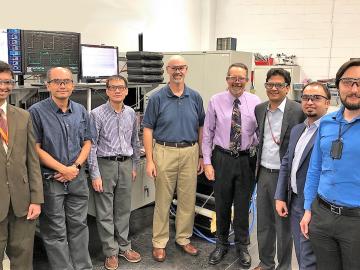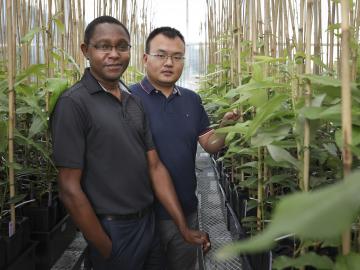
Filter News
Area of Research
- (-) Clean Energy (187)
- (-) Nuclear Systems Technology (1)
- Advanced Manufacturing (14)
- Biological Systems (15)
- Biology and Environment (42)
- Biology and Soft Matter (1)
- Building Technologies (3)
- Chemistry and Physics at Interfaces (4)
- Climate and Environmental Systems (2)
- Computational Biology (4)
- Computational Engineering (2)
- Computer Science (6)
- Electricity and Smart Grid (1)
- Energy Frontier Research Centers (7)
- Energy Sciences (3)
- Fossil Energy (2)
- Fuel Cycle Science and Technology (1)
- Functional Materials for Energy (8)
- Fusion and Fission (19)
- Fusion Energy (2)
- Geographic Information Science and Technology (2)
- Isotope Development and Production (1)
- Isotopes (10)
- Materials (226)
- Materials Characterization (2)
- Materials for Computing (13)
- Materials Synthesis from Atoms to Systems (5)
- Materials Under Extremes (5)
- National Security (25)
- Neutron Science (80)
- Nuclear Science and Technology (27)
- Nuclear Systems Modeling, Simulation and Validation (1)
- Quantum Condensed Matter (1)
- Quantum information Science (2)
- Reactor Technology (1)
- Sensors and Controls (1)
- Supercomputing (115)
- Transportation Systems (5)
News Type
News Topics
- 3-D Printing/Advanced Manufacturing (31)
- Advanced Reactors (4)
- Artificial Intelligence (5)
- Big Data (3)
- Bioenergy (14)
- Biology (5)
- Biomedical (3)
- Biotechnology (2)
- Buildings (10)
- Chemical Sciences (11)
- Clean Water (1)
- Climate Change (7)
- Composites (6)
- Computer Science (9)
- Coronavirus (4)
- Critical Materials (4)
- Cybersecurity (3)
- Decarbonization (12)
- Energy Storage (28)
- Environment (19)
- Exascale Computing (2)
- Fossil Energy (1)
- Frontier (2)
- Fusion (1)
- Grid (11)
- High-Performance Computing (3)
- Isotopes (1)
- Machine Learning (5)
- Materials (18)
- Materials Science (12)
- Mercury (1)
- Microscopy (4)
- Molten Salt (1)
- Nanotechnology (5)
- National Security (4)
- Net Zero (1)
- Neutron Science (9)
- Nuclear Energy (4)
- Partnerships (8)
- Physics (1)
- Polymers (5)
- Quantum Science (1)
- Renewable Energy (1)
- Security (3)
- Simulation (2)
- Summit (2)
- Sustainable Energy (28)
- Transformational Challenge Reactor (3)
- Transportation (19)
Media Contacts

IDEMIA Identity & Security USA has licensed an advanced optical array developed at Oak Ridge National Laboratory. The portable technology can be used to help identify individuals in challenging outdoor conditions.
A team of scientists led by Oak Ridge National Laboratory have discovered the specific gene that controls an important symbiotic relationship between plants and soil fungi, and successfully facilitated the symbiosis in a plant that

Oak Ridge National Laboratory welcomed seven technology innovators to join the third cohort of Innovation Crossroads, the Southeast’s only entrepreneurial research and development program based at a U.S. Department of Energy national laboratory.

OAK RIDGE, Tenn., May 8, 2019—Oak Ridge National Laboratory and Lincoln Electric (NASDAQ: LECO) announced their continued collaboration on large-scale, robotic additive manufacturing technology at the Department of Energy’s Advanced Manufacturing InnovationXLab Summit.

Two leaders in US manufacturing innovation, Thomas Kurfess and Scott Smith, are joining the Department of Energy’s Oak Ridge National Laboratory to support its pioneering research in advanced manufacturing.

Scientists studying a valuable, but vulnerable, species of poplar have identified the genetic mechanism responsible for the species’ inability to resist a pervasive and deadly disease. Their finding, published in the Proceedings of the National Academy of Sciences, could lead to more successful hybrid poplar varieties for increased biofuels and forestry production and protect native trees against infection.

A futuristic experiment simulating warmer environmental conditions has shown that peatland vegetation responds to higher temperatures with an earlier and longer growth period.

Brixon, Inc., has exclusively licensed a multiparameter sensor technology from the Department of Energy’s Oak Ridge National Laboratory. The integrated platform uses various sensors that measure physical and environmental parameters and respond to standard security applications.

For decades, biologists have believed a key enzyme in plants had one function—produce amino acids, which are vital to plant survival and also essential to human diets. But for Wellington Muchero, Meng Xie and their colleagues, this enzyme does more than advertised. They had run a series of experiments on poplar plants that consistently revealed mutations in a structure of the life-sustaining enzyme that was not previously known to exist.


